SEEING THE HARPY EAGLE:
a peak experience
The Harpy Eagle Harpia harpyja must be high on everyone's list
of "most wanted birds in the world." It certainly was on the first such
list that I made back in 1975, and it took me seven major trips into its
forested Neotropical habitat to finally succeed. It surely ranks right
up there with the Philippine (Monkey-eating) Eagle Pithecophaga jefferyi
as
the most impressive raptor on this earth [there is a link at the bottom
of this page that takes you to my Philippine Eagle adventure].
My story starts this way. In October 1998, my friends Steve Bailey [director
of the Pacific Grove Museum of Natural History] & Bill Keener visited
the Pantanal of Brazil on a trip arranged and led by local Brazilian guide
Paulo Boute. Upon returning, Steve gave Rita Carratello & me a pop
quiz that went something like this: which of the following did we
not
experience on our trip -- Zigzag Heron from 20 feet in daylight, a group
of Giant Otters at point blank range, scope a nest of Harpy Eagle for a
half-hour, see 200 caimans in a day. Sounded like a damn fine trip to me,
but surely he was exaggerating about the Harpy, so I picked that as the
experience they "didn't" have. Of course, the answer was "none of the above"
because they had enjoyed them all (in fact, each statement was understated;
the Harpy Eagle nest, for example, had been scoped for an hour, and the
number of caimans were actually 500/day). Steve Bailey copied his field
notes for 21 Oct 1998, at the Serra das Araras, Brazil, which read:
"Harpy Eagle -- adult at nest in large tree ... watched for
60 minutes... We did not know of this nest until yesterday, when
Maria Teresa Coelho showed us a feather! The nest has been active for about
5 years, but the Coelhos (owners of Pousada Currupira das Araras) thought
all birders would [already] know or that the bird was not important! Maria
Teresa reported that the ground under the nest is littered with cacique
nests! (suggests that the eagles rip nests off trees with occupants inside
and carry convenience-wrapped snacks back to the nest!). An exciting and
unexpected experience!"
Rita & I were enthralled by Steve's stories, and determined right there
and then to get to Brazil in time to see this Harpy Eagle nest if we could.
For us that meant August 1999, and we arranged a private tour of the Pantanal,
Serra das Araras, and Chapada dos Guimaraes National Park with Paulo Boute
[you can, too -- check out Paulo's
web site for details].
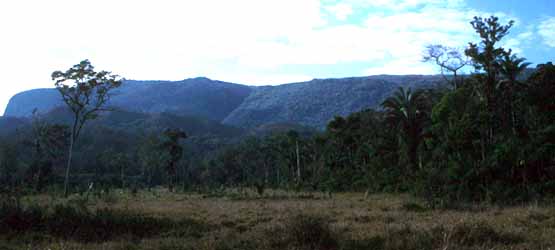
 The Serra das Araras (above) are a small mountain range, in the
state of Mato Grosso near Brazil's border with Bolivia, and from it flows
the mighty Paraguay River that creates the great marshes of the Pantanal
during flood stage. The southernmost fingers of Amazonian rain forest occur
here, growing in the valleys between steep, forested mesas. Portions of
the valleys are natural savanna and other portions have been cleared for
cattle, creating a patchwork of forest and clearings. The Pousada Currupira
das Araras has the lovely setting shown above; accommodations are comfortable
bungalows; meals are wonderful (especially the fresh-squeezed orange juice
at breakfast).
The Serra das Araras (above) are a small mountain range, in the
state of Mato Grosso near Brazil's border with Bolivia, and from it flows
the mighty Paraguay River that creates the great marshes of the Pantanal
during flood stage. The southernmost fingers of Amazonian rain forest occur
here, growing in the valleys between steep, forested mesas. Portions of
the valleys are natural savanna and other portions have been cleared for
cattle, creating a patchwork of forest and clearings. The Pousada Currupira
das Araras has the lovely setting shown above; accommodations are comfortable
bungalows; meals are wonderful (especially the fresh-squeezed orange juice
at breakfast).
The nest tree (left with Rita & I standing down below; arrow
points to the eagle nest) is actually on the edge of a protected clearing,
and reached by a short trail through the heart of the forest from the one
bisecting dirt road. When Steve & Bill first saw the nest back in October
1998, they could not see any young but, from the parents behavior (bringing
in small prey items) it was apparent there was a recent nestling. I knew
from the literature that Harpy youngsters fledge at about nine months,
which meant it was likely the eaglet would fledge in July, just before
we visited in August. I also knew that juvenals remained around the nest
site for another year or so, being fed by their parents about one a week,
until they became independent. Indeed, Paulo told us via e-mail in late
July that the fledgling was making short flights from the nest.
When Rita, Paulo, and I arrived on 3 Aug 1999, the nest was empty. Paulo
had been leading visitors here for months, always with success, but now
the possibility of missing it loomed. Fortunately, Rita took charge and
began scanning nearby trees, soon spotting the handsome youngster (below).
It already had bits of a crest, and its only reaction to us was curiosity,
peering down at us over the next hour. The parents did not appear.
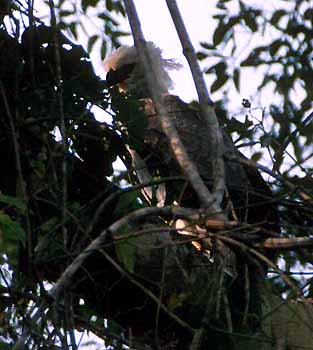
We figured that would be our experience -- great views of the big baby
eaglet by the nest tree -- and we turned to other adventures. The Serra
das Araras is very birdy with its mosaic of habitats. I was overwhelmed
by a spectacular vulture roost that included a dozen King Vultures [photo
on my vulture page],
by actually seeing a tinamou (a Tautupa), and by the huge Red-necked Woodpecker.
In fact, it was the morning that we walked along an overgrown old road
at the edge of the forest seen in the first photo above, toward the woodpecker
spot, that suddenly we flushed a giant adult Harpy Eagle from its prey
and into an adjacent tree. Having such a large raptor take off out of the
grass at such short range is really a shock! Its prey turned out to be
a Red Brocket Deer Mazama americana. The eagle was much more interested
in getting back down to the deer than it had concern for us. I was able
to scurry back to the car, grab my scope, tripod, and camera, and get back
to shoot two rolls of film on the adult (a couple of shots are below).
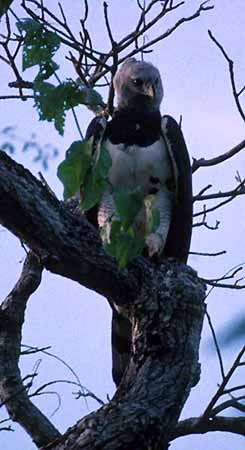
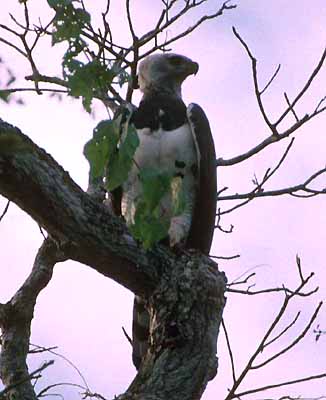
I was very close to the end of my second roll when I decided to walk
directly under the Harpy Eagle to get the sun to my back. Why I didn't
think of this before I don't know (adrenaline rushes are poor for analytic
thought, perhaps), but the view from the rear -- in much better light --
was superb. As it turns out (and isn't this always the story), I had exactly
one photo left in the camera, and here it is:
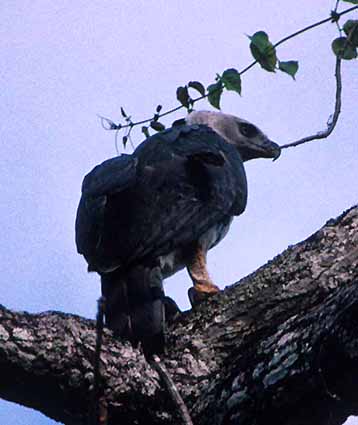
If nothing else, just look at the size of those legs and talons!
Finally the Harpy got bored of us, and glided off into the forest. We
quickly headed the other way -- towards that Red-necked Woodpecker -- in
hopes we would give the bird a clear opportunity to come pick up its prey.
And it must have done so, because the deer was gone when we returned an
hour later.... All in all, it really doesn't get much better than this.
Paulo has a great sense of humor. On arriving back at the Pousada, Paulo
found the lodge owner and told him "someone has been killing your deer!"
Shocked that poachers might have invaded, the owner became agitated: "Where?
When?," he demanded. "This morning," said Paulo, "but we know who did it."
And the owner's chagrin changed to amazement as he heard the rest of the
story. Paulo now tells me that the story of the Harpy with its deer has
morphed into legend. The story is now told of the two gringos who watched
a Harpy grab a deer right in front of their vehicle -- right on the main
road -- and carry it off to the nest....
For more information on birding Brazil with Paulo Boute or his partners,
see their
web site.
TOP
GO TO MY PHILIPPINE
EAGLE PAGE
RETURN TO LIST OF
FAMILIES OF THE WORLD
RETURN TO HOME
PAGE
RETURN TO HAWKS
& EAGLES PAGE
GO TO BIRDING
THE NEOTROPICS PAGE
Page created 14-15 Nov 1999

 The Serra das Araras (above) are a small mountain range, in the
state of Mato Grosso near Brazil's border with Bolivia, and from it flows
the mighty Paraguay River that creates the great marshes of the Pantanal
during flood stage. The southernmost fingers of Amazonian rain forest occur
here, growing in the valleys between steep, forested mesas. Portions of
the valleys are natural savanna and other portions have been cleared for
cattle, creating a patchwork of forest and clearings. The Pousada Currupira
das Araras has the lovely setting shown above; accommodations are comfortable
bungalows; meals are wonderful (especially the fresh-squeezed orange juice
at breakfast).
The Serra das Araras (above) are a small mountain range, in the
state of Mato Grosso near Brazil's border with Bolivia, and from it flows
the mighty Paraguay River that creates the great marshes of the Pantanal
during flood stage. The southernmost fingers of Amazonian rain forest occur
here, growing in the valleys between steep, forested mesas. Portions of
the valleys are natural savanna and other portions have been cleared for
cattle, creating a patchwork of forest and clearings. The Pousada Currupira
das Araras has the lovely setting shown above; accommodations are comfortable
bungalows; meals are wonderful (especially the fresh-squeezed orange juice
at breakfast).



